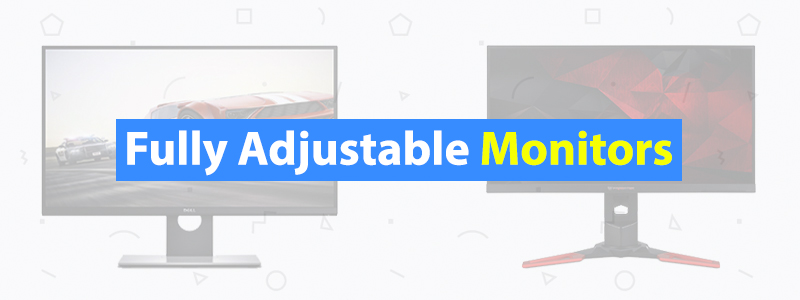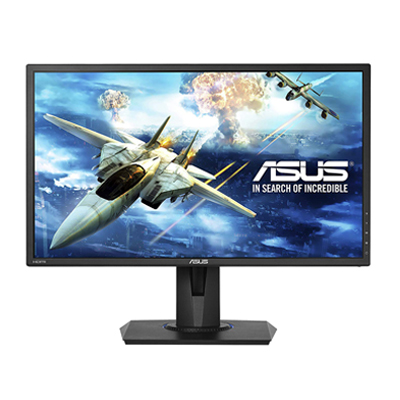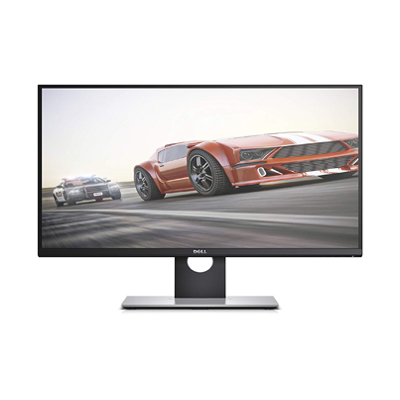5 Best Fully Adjustable and Tiltable Monitors of 2019
Not all monitors are created equally when it comes to ergonomics. Some offer a full range of adjustment options while others only offer a limited height adjustment. If ergonomics is a very important factor for you when shopping for monitors, then this guide is for you.
In this guide, you’ll find the best monitors with good ergonomics, the ones that offer not only a fully adjustable stand but also wide adjustment ranges. We came up with this product list by rounding up monitors that offer all of the following minimums: 5 inches height adjustment, 30 degrees swivel range in both directions, and 20 degrees backward tilt. Out of the monitors that meet all of those requirements, the five products listed here are the best ones.
| Budget |
|---|
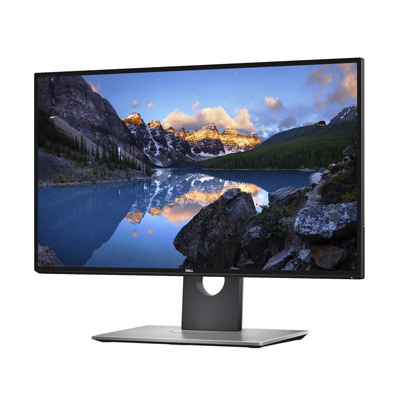 |
| Dell U2518D |
| 4.0/5.0 |
| Height Adjust: 5.1 in |
| Swivel Range: -45° to 45° |
| Tilt Range: -5° to 21° |
| Wide viewing angles, excellent color accuracy. |
| Check Amazon |
| Best Value |
|---|
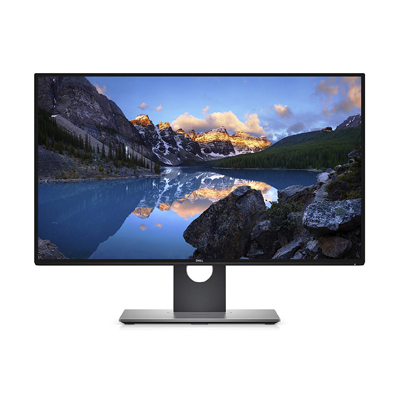 |
| Dell U2718Q |
| 4.3/5.0 |
| Height Adjust: 5.1 in |
| Swivel Range: -45° to 45° |
| Tilt Range: -5° to 21° |
| Excellent color accuracy, wide viewing angles. |
| Check Amazon |
| Top Pick |
|---|
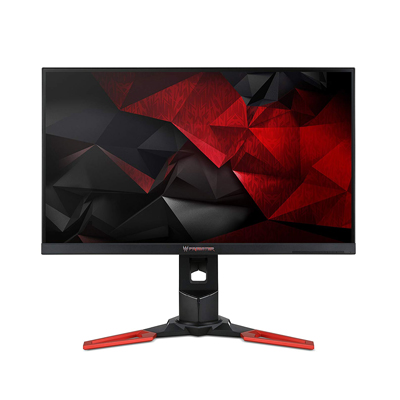 |
| Acer Predator XB271HU |
| 4.4/5.0 |
| Height Adjust: 5.9 in |
| Swivel Range: -30° to 30° |
| Tilt Range: -5° to 35° |
| Good color accuracy, wide viewing angles. |
| Check Amazon |
Best Adjustable Monitors Comparison Table
| Make and Model | Rating | Size | Resolution | Panel Type | Height Adjust | Swivel Range | Tilt Range | Weight | Price |
|---|---|---|---|---|---|---|---|---|---|
| Acer Predator XB271HU | 4.4 | 27 in | 2560 x 1440 | IPS | 5.9 in | -30° to 30° | -5° to 35° | 17.6 lb | Check Price |
| Dell U2518D | 4.0 | 25 in | 2560 x 1440 | IPS | 5.1 in | -45° to 45° | -5° to 21° | 13 lb | Check Price |
| Dell U2718Q | 4.3 | 27 in | 3840 x 2160 | IPS | 5.1 in | -45° to 45° | -5° to 21° | 13.8 lb | Check Price |
| Asus VG245H | 3.8 | 24 in | 1920 x 1080 | TN | 5.1 in | -90° to 90° | -5° to 33° | 11.2 lb | Check Price |
| Dell S2716DG | 4.0 | 27 in | 2560 x 1440 | TN | 5.1 in | -45° to 45° | -5° to 21° | 15.9 lb | Check Price |
1. Acer Predator XB271HU (Best Pick)
Editor’s Rating: 4.4/5.0
The Acer Predator XB271HU is an excellent all-around monitor that works well for both gaming and general use, featuring good color accuracy, a high refresh rate, and G-Sync support. Of the products on this list, it offers the best tilt range and height adjustment. You can get this monitor for around $700 under normal circumstances, but on a big sale, you can get it for just around $500.
A 27-inch IPS display, the XB271HU has a more understated design compared to other gaming monitors under the Acer Predator brand. It has thin bezels, with the on-screen display buttons sitting on the bottom bezel, on the right corner. The back panel is simple and has a black finish, with all of the connection ports down-facing except for a couple of USB ports on the monitor’s side. The unit comes with one HDMI port, one DisplayPort, one audio port, and a total of four USB 3.0 down ports.
The stand is sturdy and easily supports the screen, featuring red accents in some areas for a bit of flair as well as a small hole for cable management. You can adjust the height and tilt and swivel the screen, with good ranges all around. You can also pivot it to portrait mode if you want a multi-monitor setup in that screen orientation, whether it’s for gaming or productivity. It’s easy to adjust the screen position out of the box. As mentioned, this product offers the best height adjustment and tilt range among the items on this list, with a 5.9-inch max height adjustment and a backward tilt range of 35 degrees.
While clearly marketed for gaming use, the XB271HU is also an excellent monitor for productivity and general use, with its high resolution making for sharper texts and more detailed images. You can use it for media consumption, photo editing, web development, and general office work. It has good picture quality, with excellent color accuracy, but not out of the box. Without proper calibration, this Acer display is not good, so expect colors to look a bit off initially.
The XB271HU shines the most when used for pure gaming. It has a high native refresh rate of 144 Hz – which you can easily overclock to 165 Hz – and boasts excellent motion handling, with minimal motion blur during fast-paced games. It has a very low input lag, too, no matter what resolution. If you are using a Nvidia graphics card, you can also take advantage of the G-Sync support, which reduces screen tearing and stuttering when the frame rate is erratic.
Unfortunately, the XB271HU is far from perfect. It’s got a couple of issues that might prove to be deal-breakers for some of you. First, it has a low contrast ratio. While it’s a bit better than some IPS displays out there, it’s still subpar overall on that end, so don’t expect very deep blacks. And second, it has a mediocre black uniformity, which is especially noticeable when viewing dark content in a dark room.
Overall, the XB271HU is a great monitor for all-around use. It’s got good picture quality, wide viewing angles, good ergonomics, a fast response time, a low input lag, and G-Sync support. You can also check out the Asus ROG Swift PG279Q, which offers similar specs and performance. It has a slightly lower max height adjustment but offers a wider swivel range. But on the other hand, it’s more expensive, usually selling for around $800-900.
| Tech Specs |
|---|
| Size: 27 in |
| Resolution: 2560 x 1440 |
| Panel: IPS |
| Height Adjust: 5.9 in |
| Swivel Range: -30° to 30° |
| Tilt Range: -5° to 35° |
| Weight: 17.6 lb |
| The Pros |
|---|
| Good color accuracy |
| Wide viewing angles |
| Nvidia G-Sync support |
| High native refresh rate |
| Fast response time |
| Very low input lag |
| The Cons |
|---|
| Low contrast ratio |
| Mediocre black uniformity |
| Subpar out-of-box colors |
2. Dell U2518D (Best Budget)
Editor’s Rating: 4.0/5.0
When it comes to the best monitors with full adjustability, Dell is one of the best in the business, with many of its displays offering good ergonomics – and the U2518D is no exception. A 25-inch display, the U2518D is one of the best IPS monitors that you can get for $300 or less, boasting excellent color accuracy, lots of connection ports, and wide viewing angles.
On the surface, the U2518D is not much different from other models in the UltraSharp series, featuring a thin, minimalist frame with thin bezels on all sides. On the bottom bezel, you’ll find the company logo at the center, while the on-screen display buttons are on the right corner, under the bezel. The back panel has a two-tone finish, with the connection ports divided into two groups: The down-facing ports include a DisplayPort In, a DisplayPort Out, a Mini DisplayPort, an HDMI port, an audio out, and two USB 3.0 ports, while the quick-access dock on the side offers an additional pair of USB 3.0 ports.
The U2518D comes with a sturdy stand with a small hole for cable management. It’s easy to adjust the stand out of the box. You can easily adjust the height and tilt and swivel the screen, with a 5.1-inch max height adjustment and a 45-degree swivel range in both directions. The tilt range is also good, with the screen capable of tilting backward up to 21 degrees. You can also rotate the screen to portrait mode, which is useful if you want a multi-monitor setup.
Overall, this Dell UltraSharp monitor is well designed. It has good build quality, with a well-secured frame and a stable stand. The on-screen display is also good, featuring an organized structure with a good selection of calibration options. Some of you might be disappointed by the absence of speakers, though, especially if you don’t want to set aside desk space for a pair of external speakers.
The U2518D is a good all-around IPS monitor. You can use it for productivity, general use, and even gaming, though not for hardcore gaming. Unlike our top pick, it’s got excellent color accuracy out of the box, with great overall coverage for the sRGB color space, which makes it a good budget monitor for photo editing. Moreover, it has a high resolution, wide viewing angles, and good brightness – but on the other hand, it has a subpar contrast ratio and poor black uniformity.
Although the U2518D supports HDR, it’s decent at best on that front, with no wide color gamut support, so don’t expect it to produce extremely vibrant and vivid colors. Compared to monitors with true HDR, as well as HDR TVs, this Dell monitor is underwhelming. But don’t hold that against it, considering the price tag.
For gaming, the U2518D is also a solid option. It has a fast response time and a good input lag, with its high resolution allowing you to see more detail in games. If you mainly play single-player games and prefer picture quality over high refresh rates, this monitor is perfectly fine. If, however, you mostly play fast-paced multiplayer games and want everything to be as smooth and responsive as possible, this monitor is not for you.
All in all, the U2518D is an excellent monitor with good ergonomics. It works well for watching movies, graphics design, web development, internet surfing, regular gaming, and general office work, among other things. If you want a budget-friendly, fully adjustable display that offers good long-term value, get the U2518D.
| Tech Specs |
|---|
| Size: 25 in |
| Resolution: 2560 x 1440 |
| Panel: IPS |
| Height Adjust: 5.1 in |
| Swivel Range: -45° to 45° |
| Tilt Range: -5° to 21° |
| Weight: 13 lb |
| The Pros |
|---|
| Affordable price |
| Excellent color accuracy |
| Wide viewing angles |
| Good reflection handling |
| Fast response time |
| Lots of connection options |
| The Cons |
|---|
| Poor black uniformity |
| Subpar contrast ratio |
3. Dell U2718Q (Top Pick)
Editor’s Rating: 4.3/5.0
If you like our budget pick but prefer a larger screen with a higher resolution and a lower input lag, check out the Dell U2718Q, which is basically the larger version of the Dell U2518D. It sells for about $500 a piece, and as with our budget pick, it offers good long-term value, especially if you are going to use it mainly for productivity and general use.
The U2718Q looks identical to the U2518D – which isn’t surprising considering both units belong in the UltraSharp series – and offers the exact same adjustment ranges. It’s got a thin frame when viewed from the side, so it looks good when in a wall-mounted setup, and thanks to its very thin bezels, it’s also a good display for a dual-monitor setup.
It has a minimalist back panel, with one set of connection ports down-facing at the rear and another set on the monitor’s side for quick access. The number of ports is almost identical to the U2518D, with the only difference being the U2718Q’s lack of a DisplayPort Out. The down-facing ports include one HDMI port, one DisplayPort, one Mini DisplayPort, one audio port, and two USB 3.0 down ports; the side dock is composed of two more USB 3.0 down ports, one of which supports fast charging.
As with many other Dell monitors, the U2718Q features an organized and easy-to-use OSD with a nice selection of options, but don’t expect to see a lot of gaming-related options. The control buttons are located on the bottom-right corner, on the underside, and are easy to use, producing a satisfying click when pressed.
The U2718Q is great for all-around use, with its large screen and 4K UHD resolution making it a good display for multitasking with split-screen. It has good overall picture quality, with wide viewing angles, excellent color accuracy, and HDR support. While it has decent color accuracy out of the box, we recommend calibrating it as soon as possible, especially if you plan to use it for photo editing, graphics design, and other art-related work.
For gaming, the U2718Q is better than its 25-inch counterpart. It has a fast response time and a low input lag, though it’s still not a suitable option for hardcore gaming due to its limited 60 Hz refresh rate and lack of adaptive sync technology. It’s a good monitor for both PC and console gaming if you care a lot about picture quality more than anything else. If your gaming diet is mostly composed of games such as Assassin’s Creed Origins, Shadow of the Tomb Raider, and Final Fantasy XV, you’ll love this 4K display.
The U2718Q comes with the same cons as our budget pick. It has a subpar contrast ratio and is not great for viewing dark content while in a dark room. Moreover, there are no integrated speakers on this unit, so you’ll need to use external speakers or headphones for audio. It’s not all that bad that you don’t get speakers, though, considering monitor speakers are not exactly known for their sound quality.
Overall, the U2718Q is an excellent monitor, offering a 4K resolution, good color accuracy, wide viewing angles, a fast response time, and a low input lag. If you are having a difficult time choosing between this monitor and our top pick, consider your priorities first. If you want a display more suitable for gaming than productivity, get the Acer Predator XB271HU; if it’s the opposite, get the U2718Q.
| Tech Specs |
|---|
| Size: 27 in |
| Resolution: 3840 x 2160 |
| Panel: IPS |
| Height Adjust: 5.1 in |
| Swivel Range: -45° to 45° |
| Tilt Range: -5° to 21° |
| Weight: 13.8 lb |
| The Pros |
|---|
| 4K UHD resolution |
| Wide viewing angles |
| Excellent color accuracy |
| Fast response time |
| Low input lag |
| Good connectivity options |
| The Cons |
|---|
| Low contrast ratio |
| Underwhelming HDR performance |
4. Asus VG245H
Editor’s Rating: 3.8/5.0
If the products on this list were ranked according to ergonomics alone, the Asus VG245H would be tied for first place with the Acer Predator XB271HU. It’s got one of the best adjustment ranges in the business, offering a 5.1-inch max height adjustment, a 33-degree backward tilt, and a 90-degree swivel range in both directions.
Sadly, the VG245H is decent at best in most other areas, which puts it below our budget pick regarding overall value for all-around use. On the other hand, it’s a more suitable budget display for gaming – especially for PS4 and Xbox One gaming – featuring a 75 Hz refresh rate and AMD FreeSync support over HDMI, with a FreeSync range of 40-75 Hz.
Compared to most other budget TN monitors built for gaming, the VG245H has a more appealing design, featuring a stylish back panel with circuitry-like aesthetics. It has good build quality for a low-end product, with a narrow bezel and a well-built stand that offers excellent ergonomics, including the option to rotate to portrait mode. Unlike with the Dell U2518D, there are speakers on this unit, though the sound quality isn’t good.
The VG245H has an organized on-screen display, with the control panel featuring a good selection of calibration options and gaming features. Asus also did a good job with the OSD controls, with the VG245H featuring an intuitive joystick located on the bottom-right corner, on the backside, along with a set of clickable buttons. The small joystick is easy to use, though some might find it awkward to use at first.
In terms of connectivity, the VG245H is the opposite of the previous two Dell monitors, with only a basic set of ports. The down-facing ports at the bottom include a couple of HDMI ports, a VGA port, an audio out, and a mic in. That’s it. While it’s not that unusual for a budget monitor not to include a single USB port, a monitor without a DisplayPort is uncommon.
The VG245H is best used for pure gaming. It has a fast response time and a very low input lag, which makes it a suitable monitor for fast-paced games in which quick reactions are crucial. It has FreeSync support, too, which reduces screen tearing and stuttering when the frame rate is erratic. If you mainly play first-person shooters and fighting games, the VG245H is a good budget gaming monitor.
For office work and general use, the VG245H is decent at best. It has good out-of-box color accuracy and decent overall picture quality for a TN monitor. It has good reflection handling and brightness, which makes it a good monitor in a bright room. On the other hand, it has a low contrast ratio and poor black uniformity. And being a TN monitor, it has limited viewing angles, which makes its excellent ergonomics even more important.
If you want a budget monitor more suitable for gaming than the Dell U2518D, go for the VG245H instead. It’s got good build quality, outstanding ergonomics, a fast response time, a very low input lag, and FreeSync support. You can get it for a much lower price, too, with the VG245H selling for less than $200.
| Tech Specs |
|---|
| Size: 24 in |
| Resolution: 1920 x 1080 |
| Panel: TN |
| Height Adjust: 5.1 in |
| Swivel Range: -90° to 90° |
| Tilt Range: Tilt Range: -5° to 33° |
| Weight: 11.2 lb |
| The Pros |
|---|
| Outstanding ergonomics |
| Good out-of-box color accuracy |
| AMD FreeSync support |
| Fast response time |
| Very low input lag |
| Intuitive joystick control |
| The Cons |
|---|
| Limited viewing angles |
| Subpar contrast ratio |
| Mediocre black uniformity |
5. Dell S2716DG
Editor’s Rating: 4.0/5.0
The Dell S2716DG is a good alternative to the Dell U2718Q if you want something much more suitable for pure gaming. It sells for a similar price and is one of the relatively more affordable G-Sync displays out on the market. It’s got good ergonomics, offering the exact same adjustment options and ranges as the other Dell products on this list.
A 27-inch TN display, the S2716DG has a QHD resolution and a high native refresh rate of 144 Hz. It has a minimalist design, but unlike the other two Dell screens above, it has a black back panel. Other than that, the S2716DG is pretty much the same, featuring a sturdy flat stand and thin bezels, with the control buttons on the bottom-right corner.
The stand, which has the standard cable management hole, is easy to adjust. You can adjust the height, tilt, swivel, and pivot to portrait mode. As mentioned, the S2716DG offers the exact same adjustment ranges as the U2518D and U2718Q, including a 45-degree swivel range in both directions. It’s a good thing this unit has good ergonomics, considering it has a TN panel, which translates to narrow viewing angles.
While the S2716DG has more limited connection options compared to the other two Dell monitors in this guide, it’s significantly better than the Asus VG245H. It comes with one DisplayPort, one HDMI port, four USB 3.0 down ports, and a couple of audio ports, one of which allows for direct volume control. Along with the headphones port, two of the USB ports are located on the monitor’s side for quick access.
The S2716DG’s OSD is good, featuring an organized structure with a decent selection of options to choose from. On the other hand, the OSD control buttons are not that great; they don’t stick out that much, which makes them a bit difficult to press. The implementation of the control scheme is kind of surprising, actually, considering Dell is consistently good in that department.
Although the S2716DG is decent enough for office work and general use, it’s a display best used for gaming. It boasts an exceptional response time and a very low input lag, with outstanding motion handling overall, which is great for all kinds of games. With this gaming monitor, you get buttery smooth gameplay, with G-Sync taking care of screen tearing and stuttering when the frame rate is fluctuating. If you mostly play games such as Overwatch, Counter-Strike: Global Offensive, and Rocket League, the S2716DG is a recommended monitor.
In terms of overall picture quality, the S2716DG is a mixed bag. On one hand, it has an OK picture quality for a TN monitor, with decent brightness, good coverage for the sRGB color space, and good reflection handling. But on the other hand, it has narrow viewing angles, a low contrast ratio, and a disappointing black uniformity.
While not as versatile as the other Dell monitors listed here, the S2716DG is still one of the best monitors with a fully adjustable stand. It’s got a QHD resolution, good color accuracy, a high native refresh rate, G-Sync support, and excellent response time. If you can afford to spend about $500 on a gaming monitor, the S2716DG is one of the best on the market.
| Tech Specs |
|---|
| Size: 27 in |
| Resolution: 2560 x 1440 |
| Panel: TN |
| Height Adjust: 5.1 in |
| Swivel Range: -45° to 45° |
| Tilt Range: -5° to 21° |
| Weight: 15.9 lb |
| The Pros |
|---|
| Good color accuracy |
| High native refresh rate |
| Nvidia G-Sync support |
| Extremely fast response time |
| Very low input lag |
| Good connectivity options |
| The Cons |
|---|
| Limited viewing angles |
| Poor black uniformity |
| Low contrast ratio |
Contents

